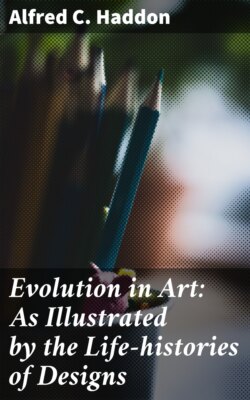Читать книгу Evolution in Art: As Illustrated by the Life-histories of Designs - Alfred C. Haddon - Страница 6
На сайте Литреса книга снята с продажи.
DECORATIVE ART OF BRITISH NEW GUINEA.
ОглавлениеTable of Contents
As stated in the Introductory section, we will commence our studies of the art of existing savages by a brief account of the decorative art of a limited area rather than wander over the earth’s surface in order to cull random examples of ornamentation. It is not sufficient to collect patterns or designs in illustration of a theory; in pursuing such a course one is, so to speak, as likely to gather tares as wheat, and they may become inextricably mixed. In my studies I have preferred to limit myself for a time to one particular district, and to gather together all the available material from that locality. The region selected was British New Guinea. By putting together all the objects in our possession known to come from any one locality, I found that the technique of the decoration and the style of the ornamentation were characteristic. It soon became apparent that British New Guinea could be divided into several artistic regions; and so it became possible to allocate to a definite district objects in museums whose exact locality was unrecorded. But this is not sufficient; it is one thing to allocate a particular pattern or group of patterns and designs to their place of origin, but quite a different matter to trace out the history or significance of the ornamentation.
In some cases the origin of a design is obvious on the face of it; in most it is easy to suggest an origin; in others even the most fertile imagination is at fault. In studies such as these the investigator should restrain from theorising as far as possible; it is a dangerous game, for more than one can play at it, and the explanation is as likely to be wrong as right. The most satisfactory plan is to gather together as much material as possible, and it will generally be found that the objects tell their own tale, and all that has to be done is to record it. When the meaning is not plain, the fault lies in the imperfection of the series, unless very great conventionalisation has already occurred, and it is wiser to wait for authoritative information than to theorise.
One great advantage in the method of confining attention to a limited area is that similar designs very probably have a genetic connection, whereas this is by no means the case if objects from different regions are compared together.
I have recently[4] published a somewhat detailed study of the decorative art of British New Guinea, to which I may refer the reader who desires to enter into more minute details. In the following account I shall first sketch the main characteristics of the art of each æsthetic region, and finally I shall discuss the influences which act on the decorative art of these and other districts of New Guinea.
